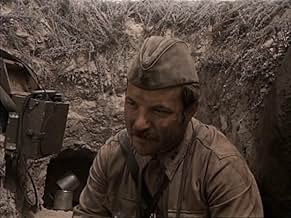Oni srazhalis za rodinu
- 1975
- 2h 38m
Ajouter une intrigue dans votre langueJuly 1942. Soviet forces are retreating in the face of a massive German onslaught towards Stalingrad. An infantry platoon is tasked with holding a vital hill in order to give their comrades ... Tout lireJuly 1942. Soviet forces are retreating in the face of a massive German onslaught towards Stalingrad. An infantry platoon is tasked with holding a vital hill in order to give their comrades time to cross the Don River and regroup.July 1942. Soviet forces are retreating in the face of a massive German onslaught towards Stalingrad. An infantry platoon is tasked with holding a vital hill in order to give their comrades time to cross the Don River and regroup.
- Prix
- 3 nominations au total
- Glikeriya
- (as Lidiya Fedoseeva)
Histoire
Le saviez-vous
- AnecdotesThis was the last film of Vasiliy Shukshin.
- GaffesDuring the first battle, a few of the Germans are carrying MP44 (or STG 44) assault rifles. This film takes place in summer 1942 and those rifles were not in service in the German army (even as prototypes) until over two years later.
- Citations
Ivan Zvyagintsev: May our love towards our country live in our hearts as long as we live.
Ivan Zvyagintsev: May our hatred to enemy always shine on the tips of our bayonets...
- ConnexionsFeatured in Sergey Bondarchuk (1982)
The film concentrates on a small number of individual regimental soldiers fighting within a larger battalion on the Russian Steppes in 1942. We are shown not noble soldiers and distinguished officers of the "glorious" Red Army, but ordinary fighting men. They are hungry, dirty, mentally and physically drained. Also, they are exhausted by their continuous 12 months retreat eastwards towards the river Donn and eventually Stalingrad. The soldiers find harmony in talking about home, family and express their emotions and feeling on the war and what it as done to them as people and their motherland. Location is presented impressively on film; firstly, by using wide angel lenses to capture the vast midst of the Steppe salt marches and corn fields. Secondly, by using close angel lenses to photograph the soldiers as they pass through, rest and interact with nervous civilians in the inhabited dwellings. With a large budget comes large battle scenes. The film shows the merciless destruction of land and villages by Luftwaffe air strikes. Defensive formations containing a whole battalion which is broad in scale and includes large battle formation shoots. The film doesn't over exaggerate when handling the destruction, human cost and horror of battle in its scenes.
The main depiction of war, battle and destruction are powerfully focused on individual soldiers. This film tells a similar story for many veteran soldiers of the second world war, whatever the nationality. Boredom, fatigue, fear, fun, friendship, enemies, orders, pain, loss, distress, death and a longing to go home.
They Fought For Their Motherland" tours the inferno imposed upon the soviet people, both military and civilian, on one side by the advancing, all concurring, disciplined German army. And on the other by years of hardship, personal sacrifice, poverty and living to the ideologist view of the soviet dictatorship. This is not the most graphic of war films in todays standard of brutal, realistic, fast passed combat movies. There are scenes of battle sustained injuries and death. However, this film focuses the humanity of war and what it does to the land, and the opinions of people in occupied nations towards the soldiers who are there to protect them. This is a patriotic film from a Russian point of view, which for many years, as at the time of release, future Russian generations, and other nations that fought in the red army, should look back with pride and honour towards those who fought, and died, for their motherland.
- richard6
- 29 janv. 2009
- Lien permanent
Meilleurs choix
- How long is They Fought for Their Country?Propulsé par Alexa
Détails
Contribuer à cette page


























